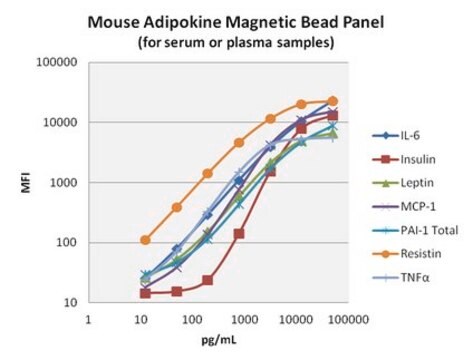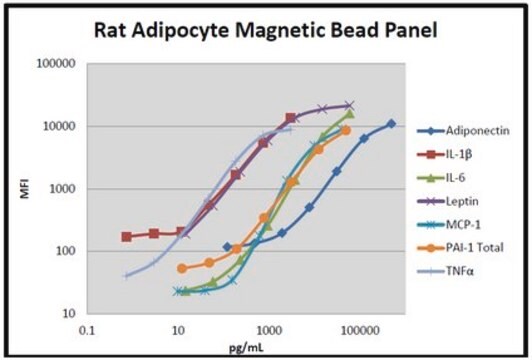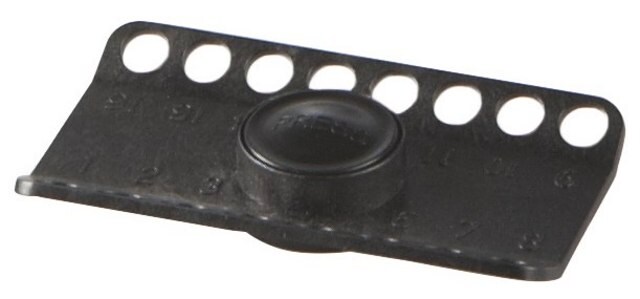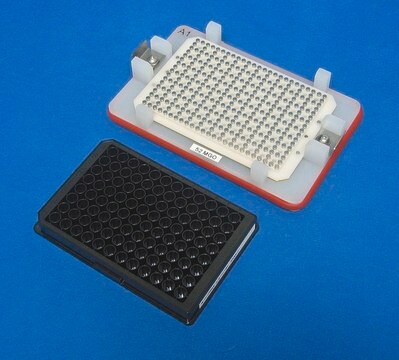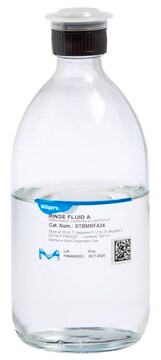HADCYMAG-61K
MILLIPLEX® Human Adipocyte Magnetic Bead Panel - Endocrine Multiplex Assay
The Human Adipocyte Magnetic Bead Panel, using the Luminex xMAP technology, enables the simultaneous analysis of 11 Adipocyte protein biomarkers in cell culture samples.
About This Item
Productos recomendados
Quality Level
species reactivity
human
manufacturer/tradename
Milliplex®
assay range
accuracy: 100%
(IL-6)
accuracy: 102%
(TNFα)
accuracy: 103%
(MCP-1)
accuracy: 83%
(PAI-1 (total))
accuracy: 99%
(HGF)
sensitivity: 0.2 pg/mL
(MinDC+2SD; IL-8)
sensitivity: 0.2 pg/mL
(MinDC+2SD; NGF)
sensitivity: 0.2 pg/mL
(MinDC+2SD; TNF?)
sensitivity: 0.6 pg/mL
(MinDC+2SD; IL-6)
sensitivity: 10 pg/mL
(MinDC+2SD; Leptin)
sensitivity: 15 pg/mL
(MinDC+2SD; Adiponectin)
sensitivity: 2.0 pg/mL
(MinDC+2SD; IL-1?)
sensitivity: 2.1 pg/mL
(MinDC+2SD; MCP-1)
sensitivity: 3.0 pg/mL
(MinDC+2SD; HGF)
sensitivity: 4.4 pg/mL
(MinDC+2SD; Resistin)
sensitivity: 4.6 pg/mL
(MinDC+2SD; PAI-1 (total))
standard curve range: 0.29-4,000 pg/mL
(IL-8)
standard curve range: 0.32-5,000 pg/mL
(NGF)
standard curve range: 0.38-6,000 pg/mL
(TNFα)
standard curve range: 0.51-8,000 pg/mL
(IL-1β)
standard curve range: 0.96-150,000 pg/mL
(IL-6)
standard curve range: 0.96-150,000 pg/mL
(MCP-1)
standard curve range: 26-400,000 pg/mL
(Adipnectin)
standard curve range: 6.4-100,000 pg/mL
(HGF)
standard curve range: 6.4-100,000 pg/mL
(Resistin)
standard curve range: 9.6-150,000 pg/mL
(Leptin)
standard curve range: 9.6-150,000 pg/mL
(PAI-1)
inter-assay cv: <15%
intra-assay cv: <10%
(Adiponectin)
inter-assay cv: <15%
intra-assay cv: <10%
(IL-8)
inter-assay cv: <15%
intra-assay cv: <10%
(MCP-1)
inter-assay cv: <15%
intra-assay cv: <10%
(Resistin)
inter-assay cv: <20%
intra-assay cv: <10%
(HGF)
inter-assay cv: <20%
intra-assay cv: <10%
(IL-6)
inter-assay cv: <20%
intra-assay cv: <10%
(NGF)
inter-assay cv: <20%
intra-assay cv: <10%
(PAI-1 (total))
inter-assay cv: <20%
intra-assay cv: <10%
(TNFα)
inter-assay cv: <20%
intra-assay cv: <15%
(IL-1β)
inter-assay cv: <25%
intra-assay cv: <20%
(Leptin)
technique(s)
multiplexing: suitable
detection method
fluorometric (Luminex xMAP)
shipped in
wet ice
General description
The MILLIPLEX® Human Adipocyte Panel is an 11-plex kit to be used for the simultaneous quantification of any or all of the following analytes in cell/tissue culture samples: Adiponectin, HGF, IL-β, IL-6, IL-8, Leptin, MCP-1, NGF, PAI-1 (total), Resistin, TNFα. This kit uses a 96-well format, contains a lyophilized standard cocktail, two internal assay quality controls and can measure up to 38 samples in duplicate.
The Luminex® xMAP® platform uses a magnetic bead immunoassay format for ideal speed and sensitivity to quantitate multiple analytes simultaneously, dramatically improving productivity while conserving valuable sample volume.
Panel Type: Metabolism
Specificity
There was no or negligible cross-reactivity between the antibodies for an analyte and any of the other analytes in this panel.
Application
- Analytes: Adiponectin, HGF, IL-1β, IL-6, IL-8, Leptin, MCP-1, NGF, PAI-1 (Total), Resistin, TNF-α
- Recommended Sample Type: Tissue/cell culture supernatants or extracts
- Recommended Sample Dilution: 25 μL per well of undiluted tissue/cell culture sample; samples may require dilution with an appropriate medium prior to assay
- Assay Run Time: Overnight (16-18 hours) at 2-8°C
- Research Category: Metabolism
- Research Subcategory: Endocrine
Features and Benefits
Packaging
Storage and Stability
Other Notes
Legal Information
Disclaimer
signalword
Danger
Hazard Classifications
Acute Tox. 3 Dermal - Acute Tox. 4 Inhalation - Acute Tox. 4 Oral - Aquatic Chronic 2 - Skin Sens. 1
Storage Class
6.1C - Combustible acute toxic Cat.3 / toxic compounds or compounds which causing chronic effects
Certificados de análisis (COA)
Busque Certificados de análisis (COA) introduciendo el número de lote del producto. Los números de lote se encuentran en la etiqueta del producto después de las palabras «Lot» o «Batch»
¿Ya tiene este producto?
Encuentre la documentación para los productos que ha comprado recientemente en la Biblioteca de documentos.
Contenido relacionado
Multiplex immunoassays, such as MILLIPLEX® multiplex metabolic assays, are critical in metabolic syndrome research because they provide a full picture of the different conditions related to it, like diabetes and obesity, as well as save time and sample volume.
Nuestro equipo de científicos tiene experiencia en todas las áreas de investigación: Ciencias de la vida, Ciencia de los materiales, Síntesis química, Cromatografía, Analítica y muchas otras.
Póngase en contacto con el Servicio técnico

